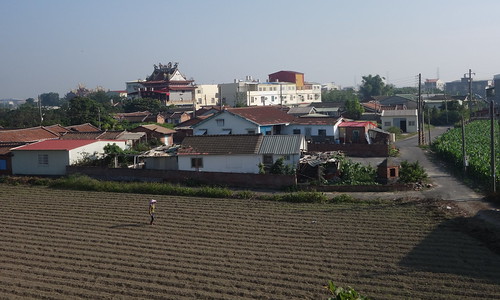The association between Leopard Cats and humans goes way back. Wiki observes of the Leopard Cat:
Archeological and morphometric studies have indicated that the first cat species to become a human commensal or domesticate in Neolithic China was the leopard cat, beginning at least 5000 years ago. However, these cats were ultimately replaced over time with cats descended from Felis sylvestris lybica from the Middle EastLeopard cats are widely spread across Asia. Historically they have been hunted for their skin. Because they are considered pests who eat domestic fowl, they are routinely poisoned by farmers throughout Asia.
I recently stumbled across Home ranges, movements and activity patterns of leopard cats (Prionailurus bengalensis) and threats to them in Taiwan by Mei-Ting Chen, Yu-Jen Liang, Chih-Chuan Kuo, and Kurtis Jai-Chyi Pei (Mammal Study 41: 000–000 (2016)). Several years ago I toured the Zoo at Pingtung Agricultural Technological University and interviewed Dr. Pei. At that time he said:
In Taiwan leopard cats are endangered. But I have a student who is studying probably Taiwan's only viable population of leopard cats up in the Hakka communities in Miaoli. Even though Taiwanese and Hakka both do agriculture, but interestingly, in the countryside inhabited by Taiwanese, there are very few leopard cats left, but in the Hakka countryside, there are many. Why? We don't know yet and hopefully we will have better understanding by the time when she finish her study.In this recent paper, based on 2006-8 data gathering, he makes the same point:
Miaoli County in northwestern Taiwan is one of three counties where Taiwanese leopard cats still exist and probably the only area where a viable population of this species can be found (Pei 2008). Recent studies in Miaoli County suggested that habitat fragmentation, degradation, road-kills due to man-made developments, and significant illegal trapping and poisoning due mainly to the retaliatory reactions for poultry loses by farmers, were major concerns of their sustainability (Pei 2008; St. John et al. 2014). Adequate ecological information, such as home range, territoriality and activity pattern, and understanding of their survival challenges are urgently needed for their conservation.The data the team gathered drives home how endangered these cats are:
A total of 3,448 trapping-night was conducted. Three Taiwanese leopard cats (M/14, F/37, and F/39) were trapped by our box-traps, and 3 (M/29, M/32, and M/33) additional cats were rescued from foot traps set illegally by farmers or hunters during the study period (Table 1). Except F/37, all other 5 individuals were found trapped by hunters or killed by farmer’s poison baits after various radio-tracking periods; for F/37, we retrieved the collar in her home range and the state of the collar suggests it was removed by a hunter (Table 1). M/33 was an unfortunate case, he was first trapped by a snare and rescued by us in January, 2007. After recovering from a minor injury and released for radio-tracking, he was found trapped again 11 months later and seriously injured this time. He was sent to the Pingtung Rescue Center for Endangered Wild Animals (PTRC) for medical treatment and care. After his second recovery and release, he was found dead due to poisoning 15 days later (Table 1). M/32 and M/14 were excluded from the analysis due to short tracking periods (for 49 days and for 60 days, respectively).In other words, all six of the animals they tracked were eventually killed by hunters or poisoned by farmers. The report concludes:
The high incidence of illegal poisoning and trapping found in this study just within a small area, i.e., total 10 incidents involving 6 individuals monitored, indicated that this anthropogenic mortality may be the profoundest mortality threatening the survival of this endangered species in Taiwan. Most of these incidents were pest-control measures carried out by local farmers who believe that Taiwanese leopard cats are pests and will continue to prey on their poultries (St. John et al. 2014). Furthermore, the dense road system in Taiwanese leopard cat country not only impedes their movement (Fig. 2), hence creating isolation, but also increases the risk of road-kill when they cross the road. At least 15 road-kill cases were reported by the media or online communities from 2012 to 2014 (personal and Taiwan Endemic Species Research Institute collected data).It will be a sad day when humanity's first cat-friend vanishes from Taiwan...
_______________________
[Taiwan] Don't miss the comments below! And check out my blog and its sidebars for events, links to previous posts and picture posts, and scores of links to other Taiwan blogs and forums!

Great post--if not exactly uplifting. Perhaps time to start educating the farmers? I wonder what Dr Pei would recommend today.
ReplyDeleteGuy
May i provide the charitable e-mail which Oracle has for humane causes: giving_ ww@oracle.com
ReplyDeleteI am a little familiar with the territory in Miaoli. It's actually quite undisturbed compared to other hilly areas with fairly dense forest so I guess that is the reason for their survival until now. Most of the hills are owned by Hakka families and they used to live up in the hills but they were given land in the 50s and moved down to the plains. The hills farms were largely abandoned.
ReplyDeleteNow the risk as far I can perceive it is increased road building, factories and temples.
Yulong and the Miaoli county government have destroyed a good portion of the leopard car land around Sanyi. There is also another mountain nearby which was leveled for a new temple a couple of years back.
All this being said,its the activities of the farmers and hunters are having a huge impact from the research conducted.